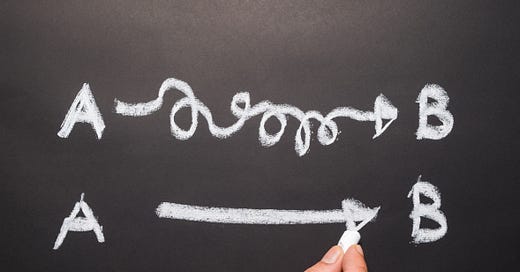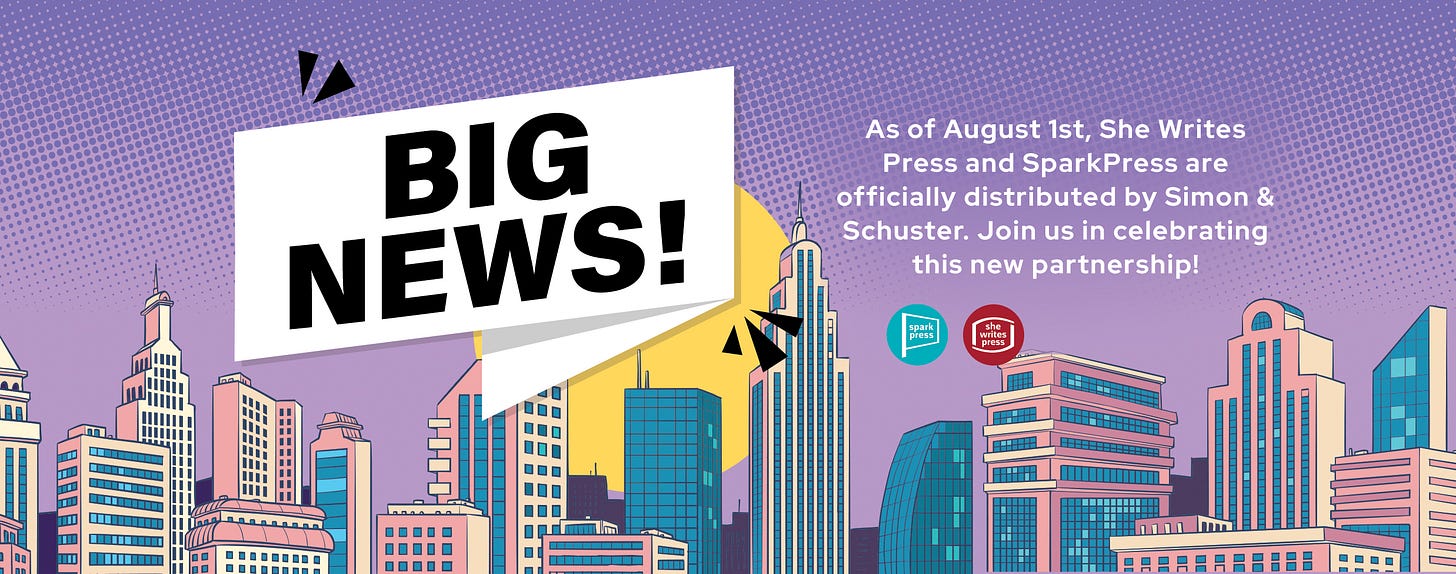Distribution for Dummies
My attempt at simplifying a complex topic on the week of our big move to Simon & Schuster for distribution
I mean no disrespect with the title of this post. Distribution is a complex concept for industry insiders, never mind for writers and authors, and it needs to be dumbed down. Among publishers, it’s a topic of great consternation and frustration because there aren’t many distributors to choose from; it’s hard to get distribution even if you want it; and once you have it, you have to deal with the inherent trade-offs.
She Writes Press and SparkPress—the two hybrid imprints I run—are celebrating this week because our go-live date with Simon & Schuster happened on Thursday. It’s official—our books are distributed by Simon & Schuster. Sounds impressive, but what does it mean?
Well, let me attempt to dumb it down . . .
A Tale of Two Methods of Distribution
Most confusing about distribution is that we use the same term for something that’s done two different ways, and the only way we distinguish between these two methods is to slap the word “traditional” in front of one of the two methods of distribution and hope everyone knows what we’re talking about. Here’s the difference, as best I can explain:
Traditional distribution
Traditional distribution happens when a publisher partners with a distribution entity, or when they do their own distribution. It involves, importantly, having dedicated sales force that actively pitches and sells books into the trade (retailers). Usually publishers partner with distributors because a publisher trying to start and do their own distribution is cost-prohibitive. Distributors (like Simon & Schuster, PGW, IPG, and others) represent multiple publishers because selling into accounts is a very specialized job. Distributors work on commission, so the more they sell, the more they make. Traditional distribution is essentially a bunch of channels for books—to bookstores, to wholesalers, to libraries, to the gift market, etc. etc. etc. Distribution involves the front end of selling books, and the back end of warehousing books, fulfilling orders, and accepting and processing returns.
Distribution
Regular distribution (not traditional) gives publishers or self-published authors a way to get their books to consumers, but it’s largely (if not exclusively) online. Amazon’s KDP and Ingram’s IngramSpark call their automated efforts “distribution,” even though I think it should be called “fulfillment” because that’s really the service on offer. There is no pushing or selling books into the trade with these services. There’s not a dedicated sales force, and as such books will not be on bookshelves on publication day (unless an author walks into their local bookstores and asks for their book to be carried). There is no warehousing or processing of returns. Books that come back are either shipped to the publisher or author, or destroyed. KDP and IngramSpark are fabulous services because they make books available and purchasable. Consumers click the buy button and the books orders are fulfilled. As long as you set the right terms, it’s possible for bookstores to order your books this way, but there’s not the above-mentioned infrastructure to make possible the processing of a lot of orders, which is why this method is so much more successful for online sales.
Pros of Traditional Distribution
Availability, access, and movement of books—this is what traditional distribution brings to the table. Books are actively pushed into bookstores, into specialty stores (places like REI, Anthropologie, or Whole Foods), into libraries, and elsewhere. Traditional distribution is an energetic force because there are human beings whose job it is to sell the books. These people (the sales force, typically 30-50 people strong) have an incentive to sell because of the commission, but also because the sales force grows to love their publisher-clients’ lists, their missions. These sales forces sells publishers’ books season in and season out, and because these are people who love books, they get invested in their publisher clients over time.
We’ve had strong personal relationships with our sales force at Ingram and PGW over all these years, so much so that leaving to go to Simon & Schuster was an emotionally wrought decision for me. Publishers are in constant contact with their distribution team—feeding them their publicity updates, pitching their new books, and sometimes even collaborating on titles and cover design.
For authors looking for a publisher, note that traditional distribution lends legitimacy. Distributors will not take on publishers whose books they don’t think they can sell. And most small and hybrid presses have to have established sales and a strong reputation to get traditional distribution in the first place. In some instances, a brand-new publisher can get traditional distribution out the gate, but the only times I’ve seen this happen has been because the publisher had an established reputation in the industry or lots of investment dollars behind them (ie, they were a pretty good bet for the distributor).
Cons of Traditional Distribution
The only con I can think of is the cost. We give up a decent percentage of our profits for the privilege of distribution. But it’s worth it. I know some publishers that can’t or won’t pursue traditional distribution because they don’t think they’ll survive the challenges it presents. Traditional distribution forces publishers to set a standard discount, and to accept returns, but that’s so that books can be available to bookstores. Bookstores will not take any book that is not set to a standard discount, and they will not order nonreturnable books.
Distribution for Self-Published Authors
If you’re a self-published author, the fact that KDP and IngramSpark exist is a game-changing development that has elevated self-publishing and means that you can sell your book online and find a readership. But if you want your books in stores, the effort falls to you—to go into bookstores and tell them about your book; to let them know you will consign your book (meaning that you’ll drop books off and come get them if and when the bookstore doesn’t want to carry them anymore, or if they’re not selling). You have to make decisions about your terms. Do you want to offer standard discounts of 55% to retailers? Do you want the books to be returnable? Do you care about the book trade, or do you want to focus your efforts on Amazon? Plenty of self-published authors go all in on Amazon, and if you don’t care to sell to bookstores, you can set your discounts as low as 30%. This strategy makes sense for some authors because you don’t have to slice your already-small pie between you, your publisher, and your distributor. The downside to this way of publishing is that you’re limiting yourself to one corner of the publishing space—Amazon—to the exclusion of lots of other opportunities.
Distribution for Hybrid-Published Authors
Because hybrid publishing is (unfortunately) the wild west of publishing, not all hybrids are created equal. Some hybrids have traditional distribution, many do not. Distribution can be a helpful measure for authors to determine the legitimacy of a hybrid publisher because the very fact of having traditional distribution suggests proven sales on the part of the publisher. That said, if a hybrid publisher does not have traditional distribution, authors need to ask questions about distribution. How are the books distributed? What are the discounts? Can the books get into bookstores? Are they returnable? Does the publisher warehouse and store books? The mechanisms of traditional distribution are ones that allow for books to be readily and easily orderable by bookstores and other retail outlets, so if you care about your book being widely available, traditional distribution is a near necessity.
Distribution for Traditionally Published Authors
Not all publishers that call themselves traditional have traditional distribution. If it’s a Big Five publisher, then yes, of course—they’re big enough that they distribute themselves (and others in the case of Simon & Schuster, Random House, and MacMillan, all of whom distribute other publishers through their distribution arms). But just as we have the complexity of the hybrid waters being muddied by so-called hybrids that don’t meet the criteria for what it means to be a legitimate hybrid publisher, so too do we have so-called traditional publishers that operate outside of the confines of what it’s traditionally meant to be a traditional publisher. Some publishers pay all the author costs and offer a royalty and still just make books available on KDP and IngramSpark. This indicates a publisher that doesn’t care about brick-and-mortar and is doubling down on online sales. They probably feel it’s not worth the cost to have a distributor, or to warehouse books. This strategy may be just fine for you, depending on your goals as an author, but you must know what you’re getting into before you sign that publishing contract.
Back to the Tale of Two Methods
Authors need to know which method of distribution a given publisher you’re considering has because it will change the way you approach your marketing and publicity, and how you talk to bookstores and other industry professionals. If you’re an author who cares about brick-and-mortar, who wants traditional reviews, who would love to see your book in libraries, then please know just how much traditional distribution plays into those efforts.
If you are embracing online, if you feel that Amazon is going to be your primary sales outlet and you’re good with that, and if you want to spend your dollars on advertising rather than publicity, then distribution might not be all that big a concern for you.
This is not a one-size-fits-all industry. There is no one right path. And distribution plays as big a role as anything when it comes to the considerations authors need to keep in mind when they’re choosing a publisher.
Thanks for reading, and hopefully you feel a little smarter on the subject of distribution for having done so. 🤓 Or maybe I didn’t deliver on my promise to simplify this at all!
This post was inspired by our move to Simon & Schuster, about which I’m incredibly happy and grateful. We worked hard to get here, and despite my neutral positions above, and my understanding and belief that distribution isn’t for everyone, we could not do what we do without it. Thank you to S&S for taking us on!







Congratulations on this new opportunity for SWP authors. Distribution is key to reaching readers, with sales reps pitching books in all those ways, plus online data outreach. As a former librarian, I mostly purchased through brokers, another layer in the system, like Follet or Mackin that featured and filtered titles and provided library services. Only traditional publishers (for the most part) were included in their databases.
Congratulations on your new distributor, and I hope the relationship is a good one :-)
Most of the authors I work with, even though lifelong readers and bookstore clients, haven't a clue how book distribution works. Thank you for this very helpful "explainer," which you can be sure I will be sharing.